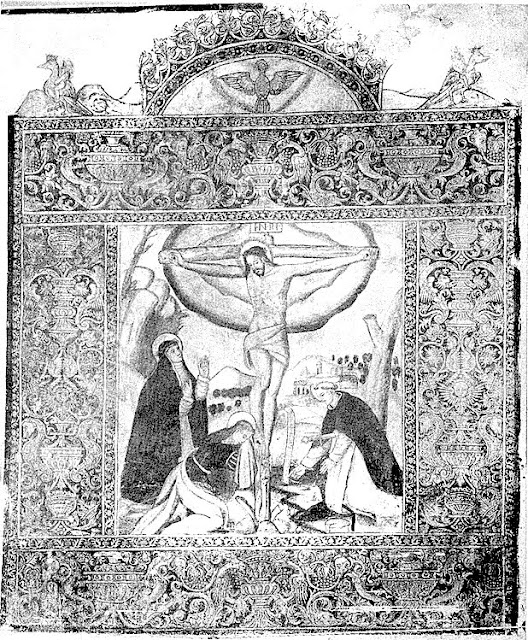As one of two principal pillars of the Catholic Church, together with St. Peter, the Apostle Paul occupies an outsize presence in Christian art. In Mexico, he features prominently in colonial architecture and altarpieces, in statuary, reliefs and paintings—including many early monastic murals.
Apart from his customary stance as a single figure, a handful of 16th century murals portray him in the context of key episodes from his life, usually in the forms of miniature accompanying scenes.
In this post we look at three such frescoes, found in the conventos of Tepeapulco (Hidalgo) Huaquechula (Puebla) and Charo (Michoacán)
Tepeapulco (Franciscan)
Located in the upper cloister, this mural portrays a magisterial St Paul in his robe standing in the center and holding his epistles and sword (the instrument of his execution.)
The figures and landscape are heavily outlined against a sepia background, with important details, like the saint's robe and blood strongly accented in reddish brown. Three large scenes unfold on either side:
On the right is his famous conversion on the road to Damascus. The saint, dressed as a Roman soldier, falls from his bucking horse. The ribbon is inscribed with an inverted, abbreviated version of Jesus' question, "Saul, Saul, why do you persecute me." ?
On the lower left we see the beheading of Paul. Blood spews from the neck of the kneeling saint as well as his severed head while the armored executioner sheathes his enormous sword.
The third scene on the upper left is ambiguous. It portrays Paul meeting with a group of dignitaries—a possible reference to his meeting with the Church Council in Jerusalem.
-------------------------
Huaquechula (Franciscan)
Located in a cell off the upper cloister, the Huaquechula mural also portrays the robed St Paul with his traditional book and sword. Two accompanying scenes behind him again illustrate the saint's conversion and execution. Here, although the outlining is lighter than at Tepeapulco with fewer incidental details, the colors are brighter and more varied, including red and turquoise washes.
The Charo portrait is accompanied by two scenes. The first, on the left, is a dramatic depiction of the saint's conversion. While his horse rears, Paul, dressed as a soldier, sprawls on the ground, his hand raised to his now blinded eyes.

On the right is outlined the scene of Paul's beheading. His head rolls on the ground as his executioner stands above him axe in hand.
-------------------
Charo (Augustinian)
Adorning the far wall in the former Refectory or Sala at Charo, this mural only portrays the episode of Paul's conversion. As at Tepeapulco, the saint sprawls on the ground below his rearing mount while a long phylactery, with a faded inscription, winds heavenward to the small figure of Jesus sitting in a cloud.
text © 2017 Richard D. Perry. color images by the author and Niccolò Brooker






















































